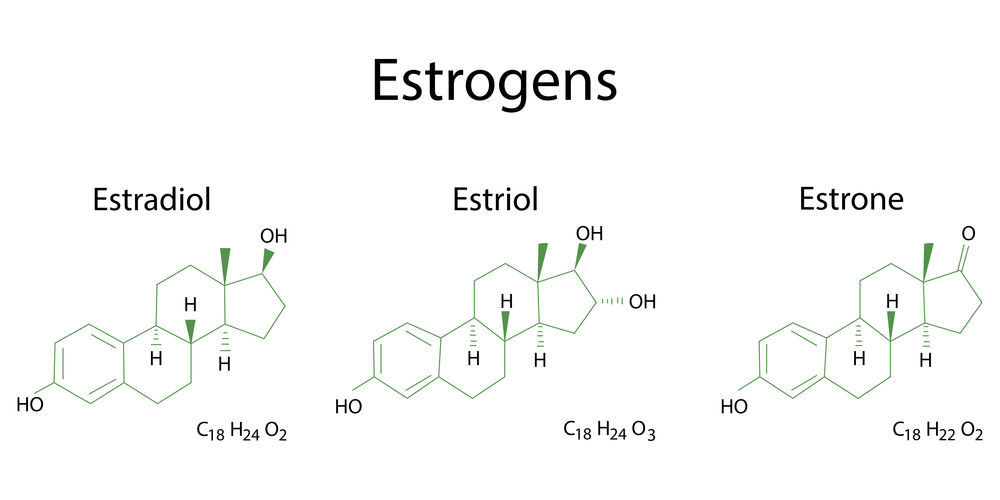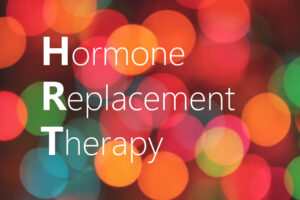 When diving into the complex world of hormones, it’s essential to understand the critical role that estrogen plays in your body. Estrogens are a group of hormones responsible for the development and regulation of female sexual and reproductive functions. Among these, estradiol and estrone are the two most prevalent forms in your body.
When diving into the complex world of hormones, it’s essential to understand the critical role that estrogen plays in your body. Estrogens are a group of hormones responsible for the development and regulation of female sexual and reproductive functions. Among these, estradiol and estrone are the two most prevalent forms in your body.
Estradiol, the most potent estrogen, is mainly produced in the ovaries and is responsible for the regulation of the menstrual cycle and the development of secondary sexual characteristics. On the other hand, estrone is a weaker form of estrogen, primarily produced in your adipose (fat) tissue and serves as a precursor to estradiol.
As you further explore the roles and functions of these specific estrogens, it’s crucial to recognize their impact on your overall health and wellbeing. The optimal balance of estradiol and estrone is vital for maintaining normal bodily functions and may even help to prevent certain health conditions.
Estrogen and Its Types
Estrogen is a vital hormone that plays a significant role in the body. It’s essential for various functions, including reproductive health and bone development. Although estrogen is commonly associated with females, it’s also present in males. In this section, you’ll learn about the three main types of estrogen: estrone, estradiol, and estriol.
Estrone (E1)
Estrone, the first type of estrogen, is derived mainly from the conversion of androstenedione in adipose (fat) tissue. While it’s considered less potent than estradiol, it’s still crucial for health. Estrone levels typically vary throughout the menstrual cycle, with the highest concentrations occurring during the follicular phase.
After menopause, estrone becomes the primary circulating estrogen in the body, as the ovaries produce less estradiol. Maintaining healthy levels of estrone is essential for bone health, cardiovascular function, and general well-being. Similar to estradiol, imbalances in estrone levels can present health challenges.
Estradiol (E2)
Estradiol is the most potent form of estrogen the body produces. It’s primarily synthesized in the ovaries and plays a crucial role in regulating the menstrual cycle, stimulating the growth of the uterine lining, and supporting the development of secondary sexual characteristics. Estradiol is also responsible for maintaining bone density and affecting your mood and cognitive function.
When it comes to the impact of estradiol on overall health, it’s important to note that balanced levels keep the body functioning optimally. Potential issues may arise if there’s either an excess or deficiency of the hormone. Some factors that can affect estradiol levels are age, body fat, and genetics.
Estriol (E3)
Estriol is considered the weakest of the three estrogens and is formed mainly during pregnancy. It’s produced by the placenta and helps safeguard a pregnancy by supplying oxygen and nutrients to the fetus. Estriol levels increase progressively throughout gestation and peak just before delivery.
Although estriol’s primary function is related to pregnancy, it has also been associated with benefits for non-pregnant individuals. For instance, estriol supplementation might alleviate menopausal symptoms and contribute to bone health. However, it’s essential to consult with a healthcare provider before considering any supplementation.
Estrogen and Reproductive Health
Reproductive health is closely related to the hormones estrogen, estradiol, and estrione. These hormones play a key role in various aspects of your reproductive system, including menstrual cycles, fertility, and pregnancy.
Menstrual Cycle
Estrogen is a vital hormone in regulating the menstrual cycle. It helps to initiate the growth of the uterine lining and prepare a woman’s body for ovulation. As the ovaries release an egg, estrogen levels fluctuate which, in turn, impacts the uterus and the release of progesterone. A balanced level of estrogen is essential for maintaining regular menstrual cycles, and any disruption to these hormone levels can lead to an irregular cycle or even menopause.
Fertility
The menstrual cycle directly affects fertility, and estrogen levels play a significant role in this process. Estrogen supports the maturation of ovarian follicles, which are necessary for the release of a viable egg during ovulation. Too low or too high levels of estrogen can lead to difficulty conceiving, as balanced hormone levels are crucial for optimal fertility. Additionally, estrogen supports the healthy growth of the uterine lining, which is essential for the implantation of a fertilized egg.
Pregnancy
During pregnancy, estrogen and progesterone are essential hormones that support a healthy gestational environment. Estrogen has multiple functions, such as:
- Increasing blood flow to the uterus
- Supporting the growth of the placenta
- Promoting the development of the baby’s organs
- Helping breasts prepare for lactation
It’s vital to regulate estrogen levels during pregnancy to ensure a healthy environment for the baby and to reduce the risk of complications.
Estrogen and Sexual Development
As you explore the role of estrogens in sexual development, you’ll learn how these hormones contribute to various aspects of puberty and sex drive. Remember that estrogens, specifically estradiol and estrone, play pivotal roles in shaping your physical and emotional growth.
Puberty
Puberty marks the phase in one’s life when the body transitions from childhood to adulthood. During this time, an increase in estrogen levels triggers the development of secondary sexual characteristics in females, such as:
- Breast growth
- Pubic and underarm hair growth
- Widening of the hips and growth spurts
- Menstruation
Estrogens work alongside other sex hormones like testosterone and progesterone to facilitate these changes. It’s important to note that testosterone, an androgen, not only functions in male sexual development but also contributes to female development.
Sex Drive
Sex drive, also known as libido, can be influenced by various factors, including hormones like estrogens and testosterone. Estrogens have been found to play a role in regulating sex drive by:
- Maintaining vaginal lubrication and elasticity
- Enhancing blood flow to the genital area
- Supporting overall sexual well-being
While estrogens can impact sex drive, it’s essential to consider that each individual’s experience varies, and other factors such as mental health, physical health, and relationships can also affect libido.
Estrogen Production and Regulation
As you explore the world of estrogen, it’s important to understand how its production and regulation occur within the body. In this section, we will take a closer look at the adrenal glands, adipose tissue, and hormone regulation.
Adrenal Glands
The adrenal glands, which sit atop the kidneys, play a vital role in the production of estrogen. These glands consist of two distinct parts: the outer cortex and the inner medulla. They synthesize and release various hormones.
Under the influence of luteinizing hormone (LH) and follicle-stimulating hormone (FSH), the adrenal cortex primarily produces androstenedione, a precursor to estrogen. This process helps maintain a proper balance of estrogen in the body throughout a lifetime.
Adipose Tissue
Adipose tissue, or body fat, is another essential site for estrogen production. This tissue contains an enzyme called aromatase, which converts androgens (such as testosterone) into estrogens, including estradiol and estrone. The more adipose tissue you have, the greater the amount of estrogen that can be produced.
Interestingly, adipose tissue can act as a reservoir for estrogen, releasing it slowly over time. This process contributes to maintaining an optimal balance of estrogen in your body.
Hormone Regulation
The regulation of estrogen production is a complex process involving a delicate balance between reproductive hormones, including LH and FSH. These hormones, released by the pituitary gland, stimulate the ovary to produce and release the egg, as well as produce estrogen.
When the levels of estrogen in the body rise, it provides negative feedback to the hypothalamus and pituitary gland, leading to a decrease in the release of LH and FSH. This feedback mechanism helps maintain a stable level of estrogen in the body.
In summary, the adrenal glands, adipose tissue, and hormone regulation all play a role in ensuring that the body maintains an appropriate balance of estrogens, including estradiol and estrone.
Estrogen and Body Functions
Estrogen, specifically estradiol and estrone, plays a crucial role in various aspects of your body’s functions. In this section, we’ll discuss the effects of estrogen on bone health, brain functions, and cardiovascular health.
Bone Health
Estrogen has a significant impact on your bone health, particularly during postmenopausal years. It helps to regulate bone remodeling by working with bone-forming cells known as osteoblasts and bone-resorbing cells called osteoclasts. As estrogen levels decrease, the balance between these cell types shifts, which can result in reduced bone strength and an increased risk of osteoporosis.
Maintaining adequate estrogen levels is crucial for the proper functioning of receptors in bone tissue. These receptors play a key role in regulating bone turnover and promoting overall bone strength. By ensuring that estrogen levels remain within healthy margins, one can minimize the risk of developing osteoporosis and other bone-related diseases.
Brain Functions
Estrogen has a protective effect on the brain, as well. It interacts with specific receptors found throughout the brain, helping to maintain synaptic connections, promote neural growth, and prevent cognitive decline. Some studies have shown that lower estrogen levels in postmenopausal women can contribute to a decreased ability to process information and recall memories.
Furthermore, estradiol and estrone are known to influence the synthesis of neurotransmitters like serotonin and dopamine, which are essential for mood regulation and overall emotional well-being. This connection may explain why low estrogen levels can be linked to mood disturbances and even depression in some individuals.
Cardiovascular Health
Estrogen plays a vital role in maintaining cardiovascular health. It has various beneficial effects on the heart, blood vessels, and fat cells. For instance, estrogen can help promote the production of nitric oxide, a compound that helps relax blood vessels and improve blood flow. This effect can lower blood pressure and reduce the risk of heart disease.
Additionally, estrogen can influence the distribution of body fat, particularly in postmenopausal women. It’s been observed that a decrease in estrogen levels can cause fat cells to accumulate around the abdomen, which is associated with an increased risk of cardiovascular disease. Therefore, maintaining healthy estrogen levels can help support optimal heart health and promote overall well-being.
Natural Approaches
If traditional hormone therapies are not suitable for your needs, there are alternative approaches available. Some options include:
- Bioidentical hormone therapy: These hormones are molecularly identical to those produced by your body, which may offer a more natural option for hormone replacement.
- Phytoestrogens: These plant-derived compounds have a similar structure to estrogen and can offer relief from certain menopause symptoms. Examples of phytoestrogens include soy products, flaxseed, and some herbs.
- Non-hormonal medications: Some medications can help alleviate menopause symptoms without the use of hormones. These options may be suitable for individuals who cannot or prefer not to use hormone therapies.
- Essential Oils: These plant-derived compounds can support optimal hormone levels. Clary Sage and Thyme are of particular benefit.
Before considering any alternative treatments, it’s essential to discuss these options with your healthcare provider to determine their safety and efficacy for your specific needs.
 Hormone Replacement Therapy
Hormone Replacement Therapy
Hormone replacement therapy (HRT) is another option to consider for maintaining your hormone levels. HRT is typically used for postmenopausal women suffering from symptoms of estrogen deficiency. The treatment options include pills, skin patches, and creams, which provide a consistent dose of estrogen to relieve symptoms.
It’s important to discuss the potential risks and benefits with your healthcare provider before starting HRT, as different individuals may have unique risk factors and health conditions.
Estrogen and Certain Medical Conditions
Understanding the role of estrogen in various medical conditions is essential for managing health. In this section, we’ll discuss the impact of estrogen on breast cancer, its effects on the prostate, and its involvement in blood clot formation.
Breast Cancer
Estrogen promotes the growth of certain breast cancers, specifically those that are estrogen receptor-positive. Estrogen binds to the estrogen receptors in cancerous cells, stimulating their growth and division. While not all breast cancers are hormone-sensitive, a significant proportion are, making estrogen an important factor to consider in breast cancer risk and treatment.
To lower estrogen levels, healthcare professionals may recommend hormone therapy for individuals with estrogen receptor-positive breast cancers. Some commonly prescribed therapies include selective estrogen receptor modulators (SERMs) and aromatase inhibitors, which help reduce estrogen production or block its effects on breast cancer cells.
Effects on the Prostate
Although estrogen is primarily associated with female reproductive health, it also plays a role in the male prostate gland. Estrogen receptors are present within the prostate tissue, and some research suggests that high levels of estrogen can promote prostate cancer growth.
Additionally, estrogen may stimulate the growth of the prostate gland itself, potentially contributing to benign prostatic hyperplasia (BPH), a common condition in aging men. If you experience symptoms associated with BPH, such as difficulty urinating, it is essential to consult a healthcare professional for a proper evaluation and treatment plan.
Blood Clots
Estrogen has been linked to an increased risk of blood clot formation, particularly in the deep veins of the legs (deep vein thrombosis) and the lungs (pulmonary embolism). This risk is more significant in individuals using some forms of hormone therapy, birth control or in postmenopausal women taking hormone replacement therapy.
To minimize the risk of blood clots, it is crucial to discuss your personal and family history of clotting disorders with your healthcare provider. They may recommend alternative therapies or adjust your treatment plan accordingly to ensure your safety.
Estrogen and Lifestyle Factors
Lifestyle plays a significant role in estrogen levels, with factors such as exercise, diet, and mood influencing the production of estradiol and estrone.
Exercise
Physical activity is known to influence estrogen levels in the body. Regular exercise can help maintain a healthy balance of these hormones. Moderate-intensity activities like walking, swimming, and yoga are especially beneficial for promoting hormonal health.
Diet
What you eat directly impacts estrogen production. Incorporating specific foods into your diet can contribute to a well-balanced hormonal environment. Some dietary recommendations include:
- Increasing intake of vegetables, particularly cruciferous ones like broccoli and kale, which contain compounds that balance estrogen levels.
- Focusing on lean protein sources, such as fish, chicken, and beans, as these can support hormone production.
Mood
Emotional well-being can also affect estrogen levels. The hormones serotonin and estrogen are interconnected, with serotonin playing a role in mood regulation. When estrogen production is imbalanced, it can impact serotonin levels, leading to mood disturbances. To support your emotional health, consider the following:
- Practice stress-reduction techniques, like meditation or deep-breathing exercises.
- Engage in activities that bring you joy and foster a sense of accomplishment.
